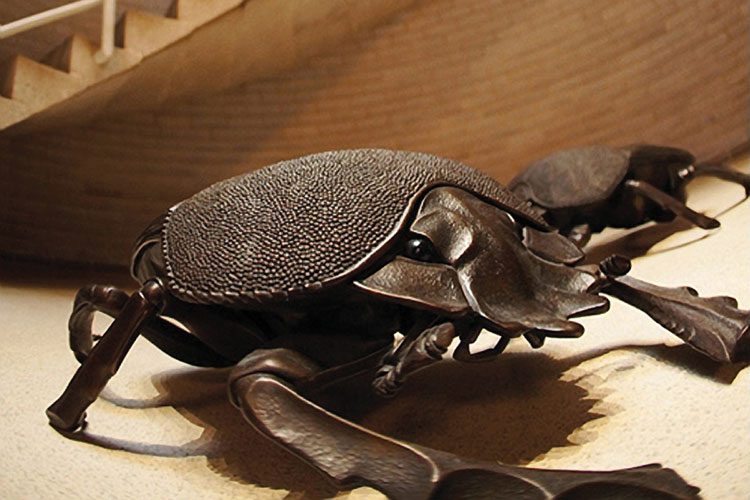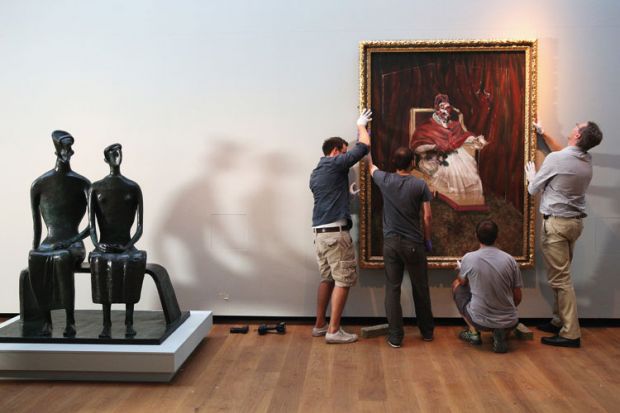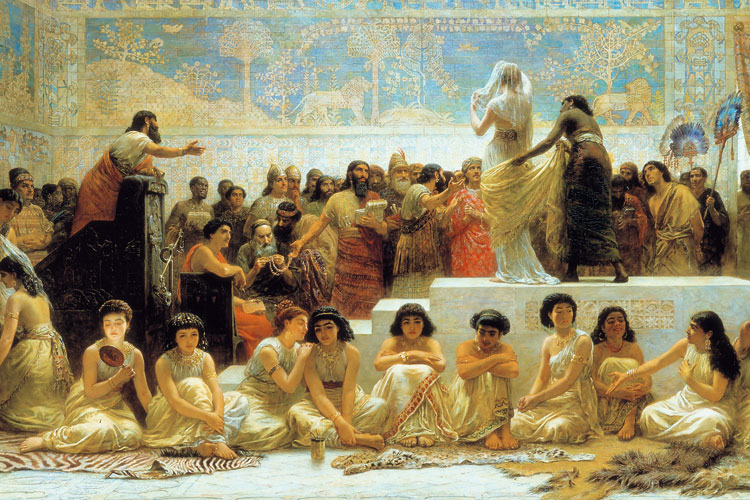On 5 October 1883, at University College, Dundee’s opening ceremony, a portrait of its founder, Mary Ann Baxter, was presented. On hand to pen an ode was William McGonagall, often regarded as “the world’s worst poet”.
The event, he writes, took place “in the College Hall,/In presence of ladies and gentlemen both great and small”. The “Right Hon W. E. Baxter was there on behalf of his aunt,/And acknowledged her beautiful portrait without any rant,/And said that she requested him to hand it over to the College,/As an incentive to others to teach the ignorant masses knowledge”.
From this inauspicious start, what is now the University of Dundee has built up an art collection of around 4,000 items. These fall into several categories: work by students and staff of the Duncan of Jordanstone College of Art and Design; the output of important Dundee artists; work that illuminates the history of Scottish art; artists’ books; and art inspired by the ideas and collections of D’Arcy Wentworth Thompson, the pioneering mathematical biologist whose celebrated 1917 book On Growth and Form influenced painters from Salvador Dalí to Jackson Pollock as much as it did scientists.
All this is fairly typical. Many universities have built up disparate art collections from rather accidental beginnings (even if few had a poet on hand to commemorate the occasion). Matthew Jarron, curator of Dundee’s museum services, says the institution hopes that its collection can play a role in “developing the talents and creativity of both students and staff” through work displayed around campus as well as in exhibitions, while also helping to “shape the social, cultural and economic life” of the city and its environs.
Although Dundee lacks an art history department, students at the art college are exposed to “examples of different printmaking or painting techniques”, Jarron adds. And the Thompson material can help spur art-science collaborations, which are now “an area of growing interest at the university”.
There are, of course, a number of universities that have major art collections on permanent display in museums or galleries. The most important, which receive significant support from the Higher Education Funding Council for England, are the University of Oxford’s Ashmolean Museum; the University of Cambridge’s Fitzwilliam Museum; the Courtauld Gallery at the Courtauld Institute of Art in London; the University of Manchester’s Whitworth Art Gallery; and the Sainsbury Centre for Visual Arts at the University of East Anglia. But what about the smaller, often more haphazard collections? Is it their function merely to put a bit of colour on the walls and remind whoever might be interested what the vice-chancellor before last looked like? Are they like the contents of an upmarket car boot sale, an irrelevant, even embarrassing inheritance that many universities don’t quite know how to handle? Or can they support their institutions’ missions and play a genuine role in teaching “the ignorant masses” (now generally known as “students”) and in other core functions, such as research and community engagement?
Many universities, or at least their press teams, seem to have little interest in their art collections: they can provide only the vaguest descriptions of them (and sometimes suggest they were merely the whim of a particular vice-chancellor).
Those that are more forthcoming include the University of Brighton. Holdings there include the Design Archives’ collection of posters, photography and artwork, plus the Aldrich Collection of art and design (which largely features work by the institution’s staff, associate members and former students, dating back to the foundation of the Brighton School of Art in 1859). The last, says a spokesman, “contributes to our ongoing institutional history”, while students in a range of disciplines “get direct access to the processes of curation, collection and archive work”. They may also be inspired by the fact that many of those “whose work is collected went on to achieve early career success”.
The University of Stirling’s collection dates back to its founding in 1967, when 1 per cent of the budget for each original building was set aside for art. The goal has always been “to make knowledge visible” through linking artworks with teaching and research. One public project last year involved working with prisoners to create art and poetry derived from paintings in the collection. In recent years, Stirling’s acquisitions policy has focused exclusively on contemporary Scottish art.
The University of Hertfordshire owns more than 500 works, mainly post-war British art but also more unexpected material, such as East German photography. Around 50 per cent of the collection is on display in offices and public meeting spaces, offering what artistic director Matthew Shaul calls “a very stylish, knowledgeable and high-minded image for visitors” to the main lounge.
Hertfordshire also has a bold programme of contemporary art exhibitions, both on its Hatfield campus (attracting about 11,000 visitors last year) and in a dedicated space within the Museum of St Albans (which is currently being refurbished). Featured work by emerging artists in subjects taught at Hertfordshire (for example, fine art, print-making and photography) is sometimes then purchased for the permanent collection.
These are all stimulating examples, but others say more about how collections can be central to institutional identity – and how those that have been neglected can be brought back to life.
Perhaps the most famous painting owned by what is now Royal Holloway, University of London depicts two ferocious polar bears savaging the human remains and other wreckage of Sir John Franklin’s unsuccessful 1845 expedition to find the North-West Passage. Painted by Edwin Landseer and unveiled in 1864, it is known as Man Proposes, God Disposes and forms part of the collection assembled by the philanthropist Thomas Holloway for his all-women’s Royal Holloway College, which opened in 1886. A strange rumour that it is cursed means that it is covered by a Union Jack during exams.
Holloway’s 77 paintings, including an iconic image by John Everett Millais of the Princes in the Tower and high Victorian pictures of everything from a Babylonian marriage market to paupers queueing up for admission to the workhouse, were united with a separate collection in 1985 when Royal Holloway merged with Bedford College. This had been put together by the artist and heiress Lady Herringham, who was closely involved in the suffrage movement and other campaigns to improve the lives of women. Along with her own versions of works by Botticelli, we find paintings by other female artists, Indian miniatures and Japanese woodcuts.
Royal Holloway caused something of a scandal in 1993 when it sold off a Constable, a Gainsborough and a Turner to raise more than £20 million for the preservation of an even more central element of its heritage, the Grade I-listed Founder’s Building. So what was to be done with the downsized and not particularly unified collection that curator Laura MacCulloch inherited when she joined the institution in autumn 2012?
Determined to improve the collection’s access and utility, she incorporates the paintings (and sometimes more fragile material that is not on display) into lectures she gives to students of drama, English, geography, history, media arts and modern languages. She has appeared on the BBC’s The One Show four times to tell the stories of individual pictures. And she has opened up the hall where some of Holloway’s original collection has always hung as a dedicated picture gallery for regular hours each week. This now attracts around 10,000 visitors a year and is hosting its first curated exhibition, Magna Carta and the Loss of Liberties in Victorian Art.
In the meantime, MacCulloch believes that the Herringham collection has been “sleeping” and “neglected as a research subject”, despite growing interest in female artists. There are signs that this is changing: for example, a PhD student will shortly start exploring it with a view to producing a catalogue.
“The founders of the University of Warwick installed modernist works of art like the flags of an egalitarian society in its public spaces,” writes current curator Sarah Shalgosky in the catalogue to a recent exhibition at the Mead Gallery, Imagining a University: Fifty Years of The University of Warwick Art Collection. Yet over time, she adds, “its early utopian ethos has given way to more domestic and educational purposes and been shaped by fiscal and arts policies”. The story offers an interesting glimpse into how the university’s founding ideals of democratic accessibility have been transformed.
Warwick was one of the seven “utopian universities” of the 1960s that pioneered different architectural styles (and ways of incorporating art within them), plus new teaching methods and curricula. Its leading architect was Eugene Rosenberg, a Czech émigré passionately interested in modern art, who once argued that “the architect can play a key role in commissioning and placing art in the buildings he designs”. He was actively supported by Warwick’s first vice-chancellor, Jack Butterworth, and given £6,000 to purchase art. The young collector Alistair McAlpine – whose family’s construction business built the university’s first phase – was persuaded to donate nine additional paintings. Most were in the bright “colour field” style of the time and filled the buildings with dramatic splashes of colour rather than pictures that encouraged people to stop and look.
Eventually Rosenberg and his team were replaced and responsibility for the art collection largely fell to the philosopher and Jesuit priest Cyril Barrett, who took the view that the university’s artwork was “for the edification, stimulation, irritation or just possibly aesthetic satisfaction of its inhabitants”. By 1970, student protest focused partly on the (now very familiar) issue of whether the university was losing its idealism and becoming too “corporate”, too focused on commercial exploitation of its estate at the expense of facilities for students.
Yet the art collection continued to grow. In 1997, Warwick was selected for the Contemporary Art Society’s Special Collection Scheme, citing as its “distinctive direction” a desire to “build upon the Collection’s relationship with the university environment”. This led to a number of commissions for particular departments: in sociology, for example, Simon Patterson created a vast map of the Southern hemisphere, Cosmic Wallpaper (2002), which incorporates the discography of the band Deep Purple, while Langlands and Bell’s Frozen Sky (2000), which adorns Warwick Business School, features a neon ring of the three-letter codes for the world’s airports.

Today, the Warwick Art Collection consists of more than 900 objects, less than 10 per cent of them in store at any given time. They are to be found, as Shalgosky puts it in the exhibition catalogue, “on open display across campus – in the grounds of the University and in over 70 different buildings”. Each one has been carefully labelled. Yet it is here that the official policy for making such work accessible encountered resistance in the form of a guerrilla critic who replaced the labels to some of the abstract paintings with trenchant comments of his own. Instead of reading about how artist Gene Davis “used hard-edged stripes to explore the dynamics of colour and space”, for example, visitors found one of his paintings dismissed as “yet another of his depressingly mundane stripy works”.
Amused by these interventions, Shalgosky mentioned to staff that she had been disappointed when they stopped turning up. The student responsible got wind of this and responded by posting on his website about how “the cheeky punk who switched the signs under more than a dozen pieces of artwork has been swatted over the head with an olive branch in the form of a tentative invitation to the summer 2009 alumni event. I’ve never known a fist-fight that could survive a hand-shake…Without the pseudo-anarchic thrill of the Swap, I’m just another guy going around putting up notices on behalf of the Mead Art Gallery, only I’m doing it for free.”
In retrospect, Shagolsky acknowledged that by “absorbing all engagement, we close down the possibility of separate discourses about the Collection and continue to position the curatorial narrative as the single, authoritative response to the art collection”. Fortunately, the artworks themselves remain wary of corporate co-option: Liliane Lijn’s huge steel and neon structure, White Koan, has its own Twitter feed (@warwickkoan), whose “views are entirely of the Koan and not of its employers”.
One example that is particularly coherent, distinctive and closely linked to the mission of its institution is the New Hall Art Collection, said to be Europe’s largest assemblage of women’s art. It is held by what is now Murray Edwards College, Cambridge, which its president, Dame Barbara Stocking, recently confirmed she wants to maintain as a female-only institution.
Although it was started as recently as 1992 with a call for donations, “the collection has grown in fits and bursts as many such collections do”, explains Eliza Gluckman, its recently appointed curator. The initial plan to target specific leading artists was “followed by a period when works were accepted in a more ad hoc way, and a more recent history that sees an excellent advisory board agree acquisitions”. Loans, gifts and bequests (but no real purchasing budget) have brought the collection’s total to some 400 items, and a fourth edition of its catalogue was recently released.
“The works in the collection are as broad in references and ideas as any might be,” continues Gluckman. Although they are mainly “wall-based” (for conservation reasons), there are also ceramics, immobile sculptures and three bronze dung beetles by Wendy Taylor that turn up all over the college. Featured artists include Mary Cassatt, Judy Chicago, Tracey Emin, Elisabeth Frink, Maggi Hambling, Dame Barbara Hepworth, Mary Kelly, Cornelia Parker, Dame Paula Rego and Bridget Riley.
A celebrated poster by the Guerrilla Girls collective asked: “Do women have to be naked to get into [New York’s Metropolitan] Museum? Less than 5 per cent of the artists in the Modern Arts sections are women, but 85% of the nudes are female.” Gluckman also points to the issue of exclusion, suggesting that “a collection of works by artists who are women within a college for women” can play a role in “highlighting the excellent, often neglected work by women” while showing “the range of creative attainment and individualism of the artists to young women”.
Yet such a collection cannot but stir up bigger questions. Is there anything distinctive about “women’s art”? (Stocking answered “yes” when asked this question on BBC Radio 4’s Today programme recently.) Are many of the (heterosexual) artists in the New Hall collection interested in portraying men overtly or ironically as sex objects? How many deal with issues of body image, domesticity, stereotyping and violence? And what about the whole genre of what Emma Rees calls “cunt art” in her 2013 book, The Vagina: A Literary and Cultural History? Some might regard the collection as relatively lacking in confrontational, “in-your-face” work – Emin, normally the “bad girl” of British art, is represented in the catalogue by a print expressing her support for the Paralympic Games – while others would argue that such work soon becomes boring after its initial shock effect.
For Gluckman, it is part of the strength of the collection that it “represents an art practice linked to a time of strident feminism and questions around female subjectivity” and also includes “works by Barbara Hepworth and Bridget Riley that would simply refuse to be a part of that conversation”. Just like anthologies, the value of “thematic” collections lies in both the quality of the work and the inevitable questions they raise about how representative they are, what they include and what they exclude. By those criteria, the New Hall Art Collection must be one of the most interesting in the country.
POSTSCRIPT:
Print headline: Art and soul
Register to continue
Why register?
- Registration is free and only takes a moment
- Once registered, you can read 3 articles a month
- Sign up for our newsletter
Subscribe
Or subscribe for unlimited access to:
- Unlimited access to news, views, insights & reviews
- Digital editions
- Digital access to THE’s university and college rankings analysis
Already registered or a current subscriber?


